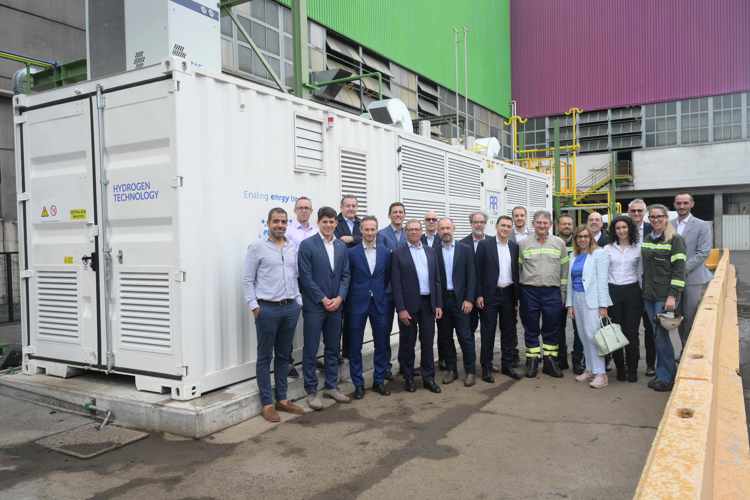
Tenaris is committed to cutting its global CO2 emissions by 30% by 2030, in line with the EU’s Fit for 55 targets. In partnership with industry leaders, including other Techint Group companies, it tests clean fuel technologies at its Dalmine facilities in Italy.

Central to the future of Tenaris’s steel pipe production strategy is decarbonization, a pledge made by the company in 2021 that envisages a 30% reduction in its specific carbon dioxide emissions worldwide by 2030 from a 2018 base level. Set against the backdrop of the European Union’s decarbonization targets, such as the Fit for 55 initiative (a 55% reduction in emissions by 2030 compared with 1990 levels), the company has joined forces with other industry leaders, including companies from the Techint Group, to trial different cleaner fuel and production technologies at the TenarisDalmine facilities in Italy.
Fabio Praolini, Environment Regional Director, shares the challenges involved in the run-up to the first-ever hydrogen trials in the Italian steel industry. The main goal has been to explore the feasibility and reliability of using hydrogen produced onsite to fuel a single burner within one existing reheating furnace with a view of being ready to reduce the plant’s CO2 emissions in the future. Praolini recalls how it all began—and the successive rounds of unexpected challenges they had to overcome.
“The initial idea was to establish whether we could use hydrogen in our steel furnaces, so we at TenarisDalmine sat down together with Tenova and Techint Engineering & Construction to see how we could develop and build a burner capable of running on up to 100% hydrogen. Then we enlisted the help to test the behavior of some of our alloys in a hydrogen-burning atmosphere. Normally, the fuel combustion process produces mainly CO2, water, and NOx. Whereas when you burn hydrogen, all you get is water and NOx, no CO2 emissions. So this changes the environment for the steel-making process, adding another layer of complexity.”
Although the concept is simple, producing hydrogen is a delicate and costly affair, still very much at the development stage. In first place, the crucial piece of equipment required is an electrolyzer that uses electricity (which can be renewably sourced, such as wind or solar, thus earning the “green hydrogen” label) to split water and separate the hydrogen from the oxygen molecules.
"This project represents a step forward in decarbonizing the steel industry by integrating green hydrogen into high-temperature processes. The collaboration between Tenova, Snam, TenarisDalmine, and Techint Engineering & Construction will validate the performance and safety of hydrogen in steel production, setting a crucial precedent for its adoption in hard-to-abate sectors. This initiative tests hydrogen's viability as a sustainable fuel and lays the groundwork for future large-scale decarbonization efforts," underscored Antonio Catalano, Tenova EVP, Downstream BU.
As Praolini remembers, sourcing the electrolyzer proved to be a tougher challenge than expected: “First, we signed a preliminary agreement with a supplier, but they had problems with safety and containment issues and couldn’t follow through. Then Snam said they were interested in participating in the project and would source the electrolyzer rather than the finished product. It took another nine months of investigating this option before the decision was taken to go with another supplier. It was only in early 2024 that we located an electrolyzer made by ErreDue, which is a small company, so there is this sense of it being an artisanal creation, and although it’s a good piece of equipment, it’s still problematic as I feel that it needs some development to improve reliability.”
Snam, a leading European energy infrastructure and services company, provided the electrolyzers, Tenova manufactured the hydrogen burners, and Techint E&C designed the whole system, from electricity to piping, ran the risk analysis, and ensured safety compliance.
In addition to the setbacks surrounding the electrolyzer, there were a few other hiccups in the process, such as problems with pipes which kept springing leaks at critical points. However, he’s adamant that overall, it’s been a highly positive experience. “This project, developed in collaboration with Tenova and Techint, was a great experience. We quickly realized that the real challenge was about getting everything to click at the right moment with the right people,” he shares. The team was laser-focused on acquiring as much know-how as possible about working with hydrogen, all while racing to build the whole pilot installation.
In fact, there are experts from all around the Techint Group collaborating on this project: the Maintenance Engineering team from Dalmine, the environmental and safety departments, and the line managers from the rolling mill. Heading up the group is the furnace support team from Maintenance Engineering in TenarisDalmine, and a handful of people from Techint E&C and Tenova.
“This project demonstrated the great potential of collaboration among the three companies in Italy on energy transition initiatives. From our perspective, one of the most interesting aspects was the risk analysis performed to introduce hydrogen in a plant not originally designed to cope with it. In that regard, we incorporated valuable expertise given the future expansion of hydrogen utilization,” remarked Andrea Cignoli, Country Director Techint E&C Italy.
Praolini also draws attention to another key factor in the efficiency equation: cost, as hydrogen is highly expensive. He observes that the key to making green hydrogen competitive for steel production lies in one thing: ultra-low-cost renewable electricity. “Without that, it’s a tough sell.”
Tenaris is taking on the challenge of slashing CO2 emissions across every stage of the steel and pipe production process. It’s upping scrap rates, increasing the use of renewable electricity, and boosting energy efficiency as well as exploring new tech alternatives for carbon capture and hydrogen—just like what we’re working on today.
These will be a valuable complement to the use of natural gas at its facilities. As the engineer concludes, “In what’s known as a hard-to-abate sector like the steel industry, green hydrogen is emerging as a long-term game-changer to meet both regional and global goals. This project marks an major step in that direction.”